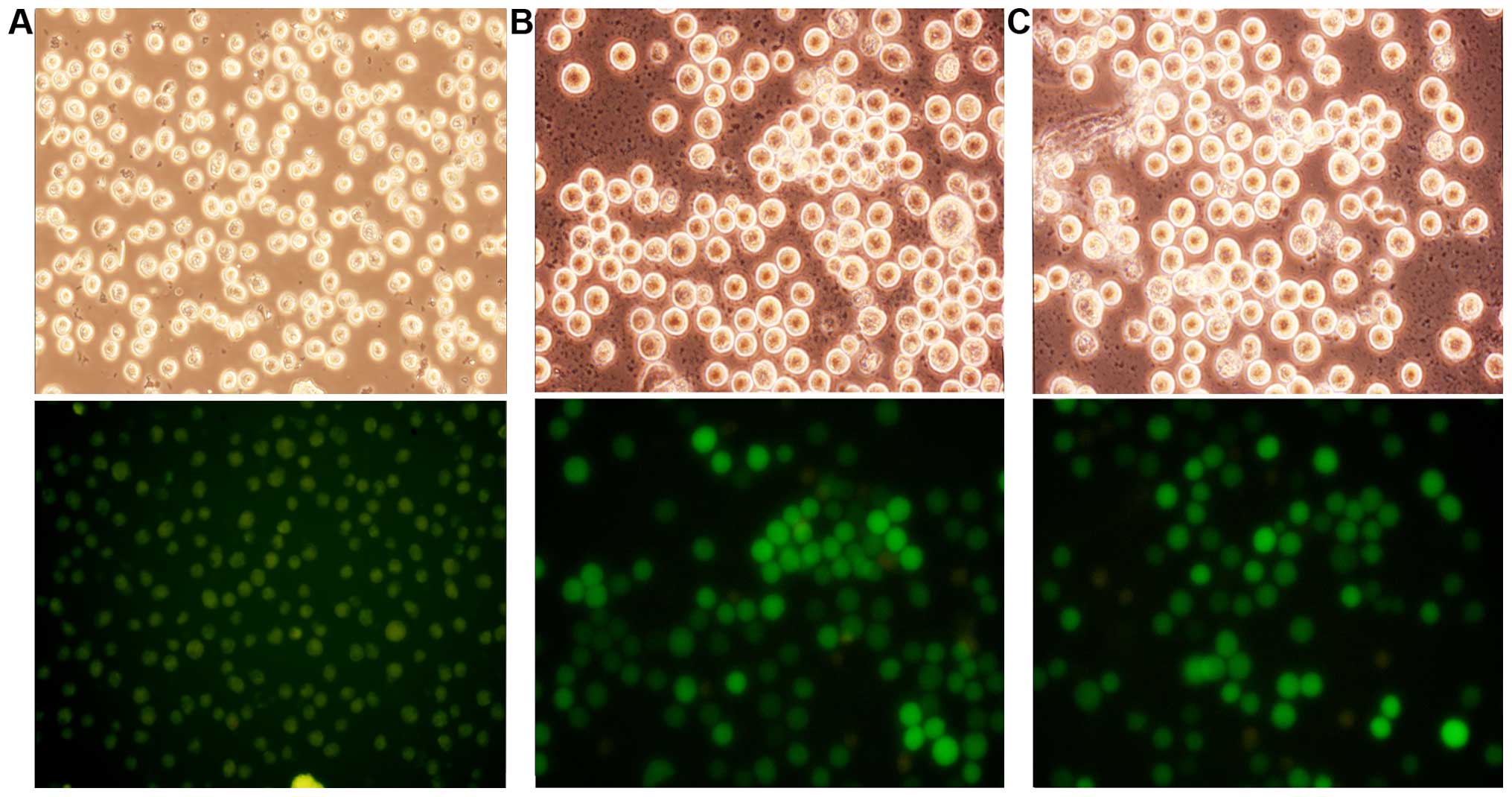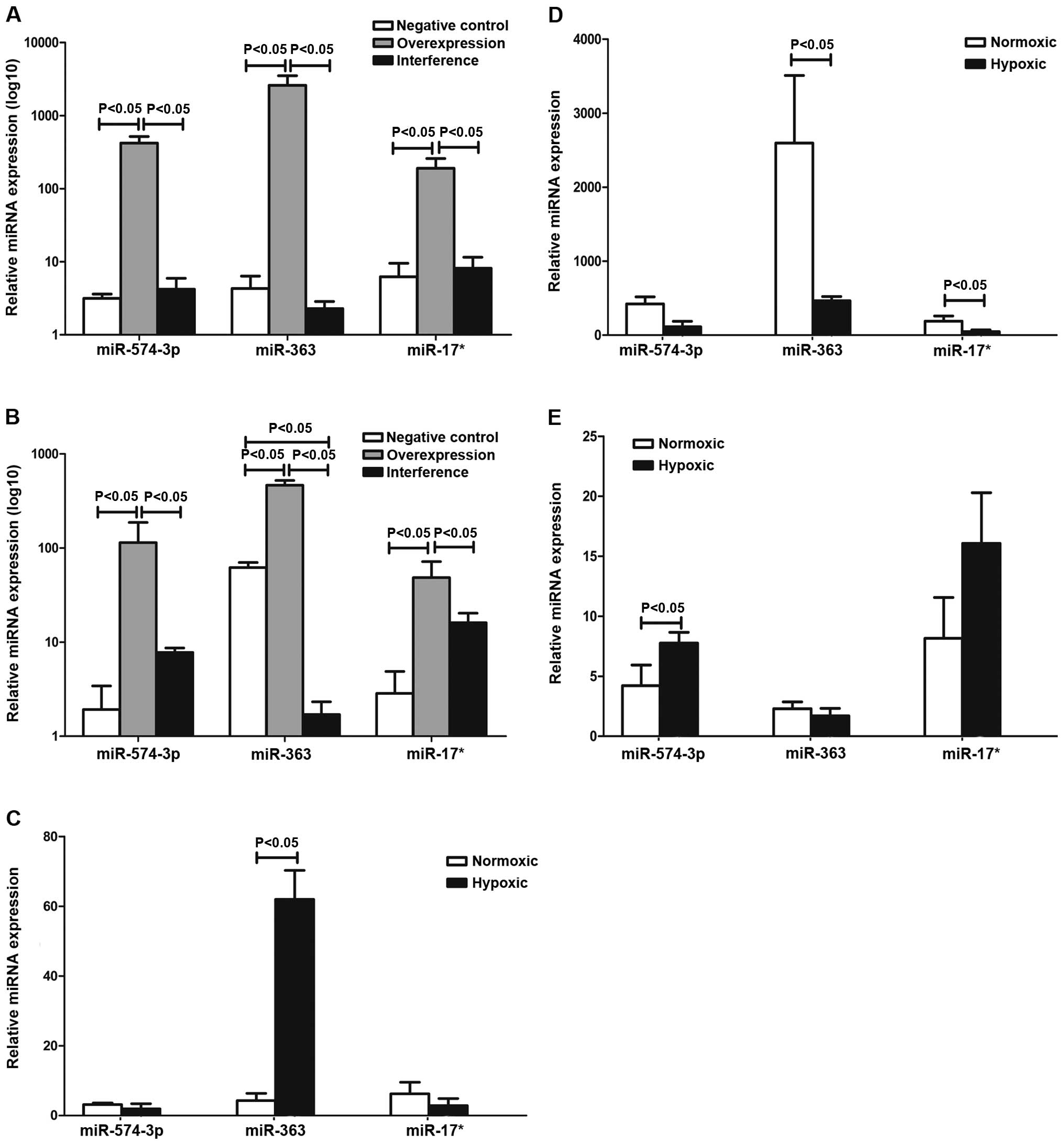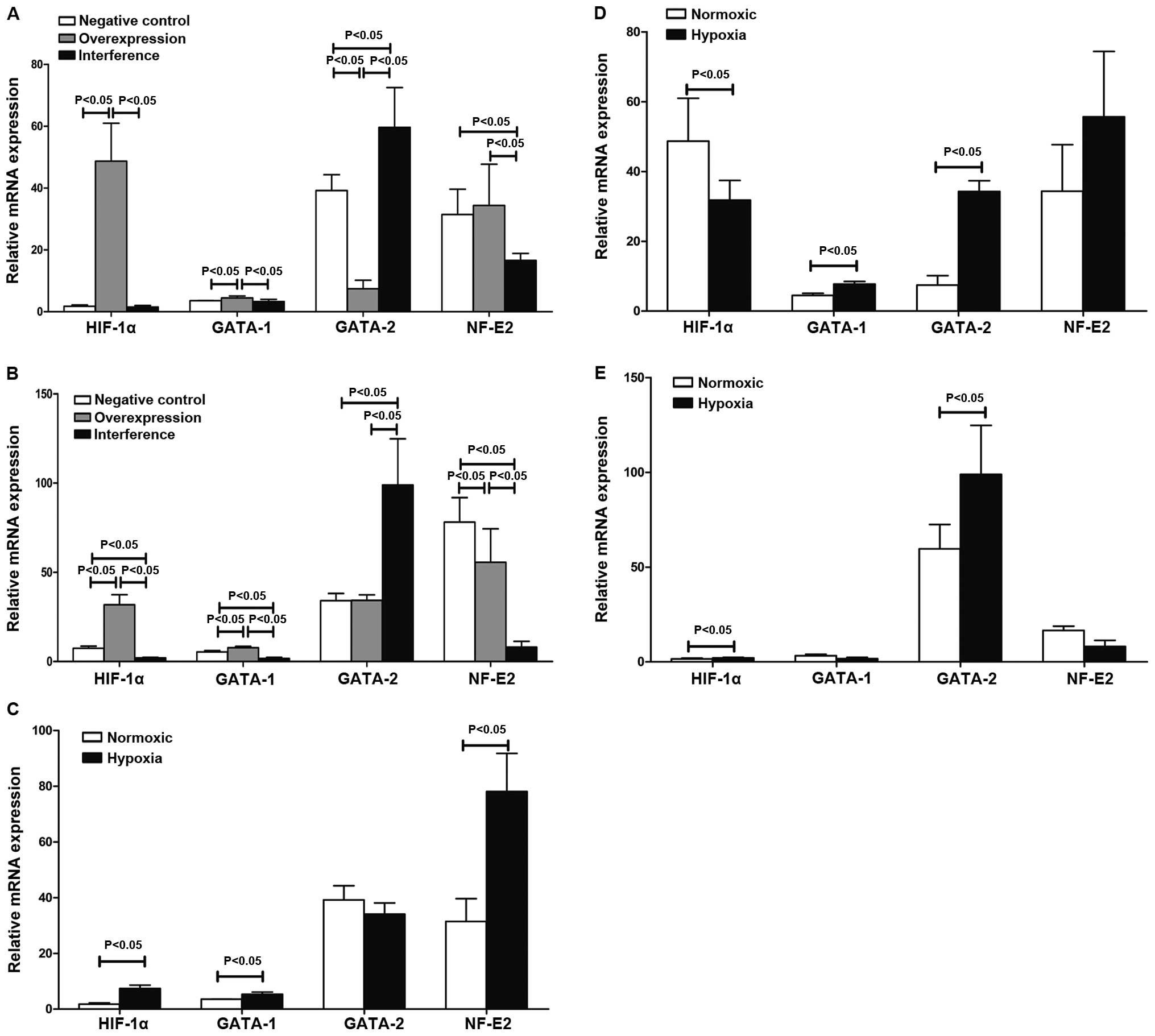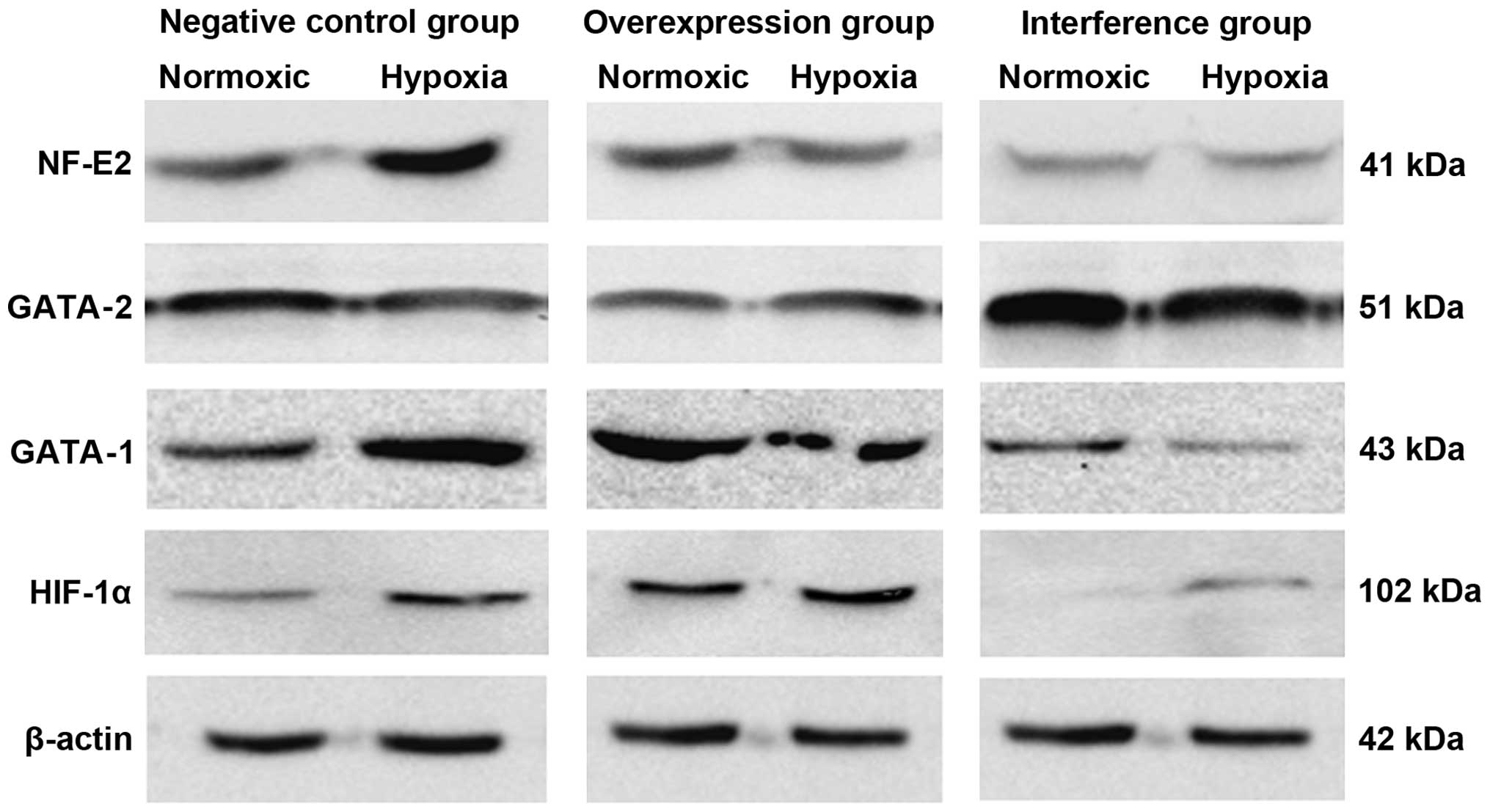|
1
|
Hattangadi SM, Wong P, Zhang L, et al:
From stem cell to red cell: regulation of erythropoiesis at
multiple levels by multiple proteins, RNAs, and chromatin
modifications. Blood. 118:6258–6268. 2011. View Article : Google Scholar : PubMed/NCBI
|
|
2
|
Undi RB, Kandi R and Gutti RK: MicroRNAs
as haematopoiesis regulators. Adv Hematol. 2013:695–754. 2013.
View Article : Google Scholar
|
|
3
|
Ha M and Kim VN: Regulation of microRNA
biogenesis. Nat Rev Mol Cell Biol. 15:509–524. 2014. View Article : Google Scholar : PubMed/NCBI
|
|
4
|
Zhao S and Liu M: The progress of microRNA
mechanism and research. China Science C Series. 39:109–113.
2009.
|
|
5
|
Hashimoto K, Otero M, Imagawa K, de Andrés
MC, Coico JM, Roach HI, Oreffo RO, Marcu KB and Goldring MB:
Regulated transcription of human matrix metalloproteinase 13
(MMP13) and interleukin-1β (IL1B) genes in chondrocytes depends on
methylation of specific proximal promoter CpG sites. J Biol Chem.
288:10061–10072. 2013. View Article : Google Scholar : PubMed/NCBI
|
|
6
|
Cai L: Epigenetic frontier (M) Beijing.
Tsinghua University Press. 2012. 133–142. 2012.
|
|
7
|
Tsai FY, Keller G, Kuo FC, Weiss M, Chen
J, Rosenblatt M, Alt FW and Orkin SH: An early haematopoietic
defect in mice lacking the transcription factor GATA-2. Nature.
371:221–226. 1994. View
Article : Google Scholar : PubMed/NCBI
|
|
8
|
Tsai FY and Orkin SH: Transcription factor
GATA-2 is required for proliferation/survival of early
hematopoietic cells and mast cell formation, but not for erythroid
and myeloid terminal differentiation. Blood. 89:3636–3643.
1997.PubMed/NCBI
|
|
9
|
Vicente C, Conchillo A, García-Sánchez MA
and Odero MD: The role of the GATA2 transcription factor in normal
and malignant hematopoiesis. Crit Rev Oncol Hematol. 82:1–17. 2012.
View Article : Google Scholar
|
|
10
|
Ferreira R, Ohneda K, Yamamoto M and
Philipsen S: GATA1 function, a paradigm for transcription factors
in hematopoiesis. Mol Cell Biol. 25:1215–1227. 2005. View Article : Google Scholar : PubMed/NCBI
|
|
11
|
Pevny L, Simon MC, Robertson E, Klein WH,
Tsai SF, D'Agati V, Orkin SH and Costantini F: Erythroid
differentiation in chimaeric mice blocked by a targeted mutation in
the gene for transcription factor GATA-1. Nature. 349:257–260.
1991. View
Article : Google Scholar : PubMed/NCBI
|
|
12
|
Pevny L, Lin CS, D'Agati V, Simon MC,
Orkin SH and Costantini F: Development of hematopoietic cells
lacking transcription factor GATA-1. Development. 121:163–172.
1995.PubMed/NCBI
|
|
13
|
Zon LI, Youssoufian H, Mather C, Lodish HF
and Orkin SH: Activation of the erythropoietin receptor promoter by
transcription factor GATA-1. Proc Natl Acad Sci USA.
88:10638–10641. 1991. View Article : Google Scholar : PubMed/NCBI
|
|
14
|
Lacombe C and Mayeux P: The molecular
biology of erythropoietin. Nephrol Dial Transplant. 14(Suppl 2):
22–28. 1999. View Article : Google Scholar : PubMed/NCBI
|
|
15
|
Zhou Z, Li X, Deng C, Ney PA, Huang S and
Bungert J: USF and NF-E2 cooperate to regulate the recruitment and
activity of RNA polymerase II in the beta-globin gene locus. J Biol
Chem. 285:15894–15905. 2010. View Article : Google Scholar : PubMed/NCBI
|
|
16
|
Kapralova K, Lanikova L, Lorenzo F, Song
J, Horvathova M, Divoky V and Prchal JT: RUNX1 and NF-E2
upregulation is not specific for MPNs, but is seen in polycythemic
disorders with augmented HIF signaling. Blood. 123:391–394. 2014.
View Article : Google Scholar :
|
|
17
|
Li Y, Bai H, Zhang Z, Li W, Dong L, Wei X,
Ma Y, Zhang J, Yu J, Sun G, et al: The up-regulation of miR-199b-5p
in erythroid differentiation is associated with GATA-1 and NF-E2.
Mol Cells. 37:213–219. 2014. View Article : Google Scholar : PubMed/NCBI
|
|
18
|
Wang F, Zhu Y, Guo L, Dong L, Liu H, Yin
H, Zhang Z, Li Y, Liu C, Ma Y, et al: A regulatory circuit
comprising GATA1/2 switch and microRNA-27a/24 promotes
erythropoiesis. Nucleic Acids Res. 42:442–457. 2014. View Article : Google Scholar
|
|
19
|
Xu H, Iyer N, Huettner JE and
Sakiyama-Elbert SE: A puromycin selectable cell line for the
enrichment of mouse embryonic stem cell-derived V3 interneurons.
Stem Cell Res Ther. 6:2202015. View Article : Google Scholar : PubMed/NCBI
|
|
20
|
Livak KJ and Schmittgen TD: Analysis of
relative gene expression data using real-time quantitative PCR and
the 2(-Delta Delta C(T)) method. Methods. 25:402–408. 2001.
View Article : Google Scholar
|
|
21
|
Hattangadi SM, Wong P, Zhang L, Flygare J
and Lodish HF: From stem cell to red cell: regulation of
erythropoiesis at multiple levels by multiple proteins, RNAs, and
chromatin modifications. Blood. 118:6258–6268. 2011. View Article : Google Scholar : PubMed/NCBI
|
|
22
|
Doré LC, Chlon TM, Brown CD, White KP and
Crispino JD: Chromatin occupancy analysis reveals genome-wide GATA
factor switching during hematopoiesis. Blood. 119:3724–3733. 2012.
View Article : Google Scholar : PubMed/NCBI
|
|
23
|
Bresnick EH, Lee HY, Fujiwara T, Johnson
KD and Keles S: GATA switches as developmental drivers. J Biol
Chem. 285:31087–31093. 2010. View Article : Google Scholar : PubMed/NCBI
|
|
24
|
Grass JA, Boyer ME, Pal S, Wu J, Weiss MJ
and Bresnick EH: GATA-1-dependent transcriptional repression of
GATA-2 via disruption of positive autoregulation and domain-wide
chromatin remodeling. Proc Natl Acad Sci USA. 100:8811–8816. 2003.
View Article : Google Scholar : PubMed/NCBI
|
|
25
|
Martowicz ML, Grass JA, Boyer ME, Guend H
and Bresnick EH: Dynamic GATA factor interplay at a multicomponent
regulatory region of the GATA-2 locus. J Biol Chem. 280:1724–1732.
2005. View Article : Google Scholar
|
|
26
|
Grass JA, Jing H, Kim SI, Martowicz ML,
Pal S, Blobel GA and Bresnick EH: Distinct functions of dispersed
GATA factor complexes at an endogenous gene locus. Mol Cell Biol.
26:7056–7067. 2006. View Article : Google Scholar : PubMed/NCBI
|
|
27
|
Wightman B, Ha I and Ruvkun G:
Posttranscriptional regulation of the heterochronic gene lin-14 by
lin-4 mediates temporal pattern formation in C. elegans. Cell.
75:855–862. 1993. View Article : Google Scholar : PubMed/NCBI
|
|
28
|
Lee RC, Feinbaum RL and Ambros V: The C.
elegans hetero chronic gene lin-4 encodes small RNAs with antisense
complementarity to lin-14. Cell. 75:843–854. 1993. View Article : Google Scholar : PubMed/NCBI
|
|
29
|
Wang Q, Huang Z, Xue H, Jin C, Ju XL, Han
JD and Chen YG: MicroRNA miR-24 inhibits erythropoiesis by
targeting activin type I receptor ALK4. Blood. 111:588–595. 2008.
View Article : Google Scholar
|
|
30
|
Fu YF, Du TT, Dong M, Zhu KY, Jing CB,
Zhang Y, Wang L, Fan HB, Chen Y, Jin Y, et al: Mir-144 selectively
regulates embryonic alpha-hemoglobin synthesis during primitive
erythropoiesis. Blood. 113:1340–1349. 2009. View Article : Google Scholar
|
|
31
|
Patrick DM, Zhang CC, Tao Y, Yao H, Qi X,
Schwartz RJ, Jun-Shen Huang L and Olson EN: Defective erythroid
differentiation in miR-451 mutant mice mediated by 14-3-3zeta.
Genes Dev. 24:1614–1619. 2010. View Article : Google Scholar : PubMed/NCBI
|
|
32
|
Rasmussen KD, Simmini S, Abreu-Goodger C,
Bartonicek N, Di Giacomo M, Bilbao-Cortes D, Horos R, Von Lindern
M, Enright AJ and O'Carroll D: The miR-144/451 locus is required
for erythroid homeostasis. J Exp Med. 207:1351–1358. 2010.
View Article : Google Scholar : PubMed/NCBI
|
|
33
|
Yu D, dos Santos CO, Zhao G, Jiang J,
Amigo JD, Khandros E, Dore LC, Yao Y, D'Souza J, Zhang Z, et al:
miR-451 protects against erythroid oxidant stress by repressing
14-3-3zeta. Genes Dev. 24:1620–1633. 2010. View Article : Google Scholar : PubMed/NCBI
|
|
34
|
Sankaran VG, Menne TF, Šćepanović D,
Vergilio JA, Ji P, Kim J, Thiru P, Orkin SH, Lander ES and Lodish
HF: MicroRNA-15a and -16-1 act via MYB to elevate fetal hemoglobin
expression in human trisomy 13. Proc Natl Acad Sci USA.
108:1519–1524. 2011. View Article : Google Scholar : PubMed/NCBI
|
|
35
|
Zhang L, Flygare J, Wong P, Lim B and
Lodish HF: miR-191 regulates mouse erythroblast enucleation by
down-regulating Riok3 and Mxi1. Genes Dev. 25:119–124. 2011.
View Article : Google Scholar : PubMed/NCBI
|
|
36
|
Georgantas RW III, Hildreth R, Morisot S,
Alder J, Liu CG, Heimfeld S, Calin GA, Croce CM and Civin CI:
CD34+ hematopoietic stem-progenitor cell microRNA
expression and function: a circuit diagram of differentiation
control. Proc Natl Acad Sci USA. 104:2750–2755. 2007. View Article : Google Scholar
|
|
37
|
Norfo R, Zini R, Pennucci V, Bianchi E,
Salati S, Guglielmelli P, Bogani C, Fanelli T, Mannarelli C, Rosti
V, et al: Associazione Italiana per la Ricerca sul Cancro Gruppo
Italiano Malattie Mieloproliferative Investigators: miRNA-mRNA
integrative analysis in primary myelofibrosis CD34+
cells: role of miR-155/JARID2 axis in abnormal megakaryopoiesis.
Blood. 124:e21–e32. 2014. View Article : Google Scholar : PubMed/NCBI
|
|
38
|
Crispino JD, Lodish MB, MacKay JP and
Orkin SH: Use of altered specificity mutants to probe a specific
protein-protein interaction in differentiation: the GATA-1:FOG
complex. Mol Cell. 3:219–228. 1999. View Article : Google Scholar : PubMed/NCBI
|
|
39
|
Jelkmann W: Molecular biology of
erythropoietin. Intern Med. 43:649–659. 2004. View Article : Google Scholar : PubMed/NCBI
|
|
40
|
Fried W: Erythropoietin and
erythropoiesis. Exp Hematol. 37:1007–1015. 2009. View Article : Google Scholar : PubMed/NCBI
|
|
41
|
Zhang FL, Shen GM, Liu XL, Wang F, Zhao YZ
and Zhang JW: Hypoxia-inducible factor 1-mediated human GATA1
induction promotes erythroid differentiation under hypoxic
conditions. J Cell Mol Med. 16:1889–1899. 2012. View Article : Google Scholar
|
|
42
|
Weiss MJ and Orkin SH: GATA transcription
factors: key regulators of hematopoiesis. Exp Hematol. 23:99–107.
1995.PubMed/NCBI
|
|
43
|
Orkin SH: GATA-binding transcription
factors in hematopoietic cells. Blood. 80:575–581. 1992.PubMed/NCBI
|
|
44
|
Moriguchi T and Yamamoto M: Network
regulation of Gata1 and Gata2 gene-dynamics underlies erythroid
differentiation. Rinsho Ketsueki. 55:633–642. 2014.In Japanese.
PubMed/NCBI
|
|
45
|
Yang Y, Ma W, Wu D, Huang Y, Li H, Zou J,
Zhang Y, Feng M and Luo J: MiR-17 partly promotes hematopoietic
cell expansion through augmenting HIF-1α in osteoblasts. PLoS One.
8:e702322013. View Article : Google Scholar
|
|
46
|
Bianchi N, Zuccato C, Lampronti I,
Borgatti M and Gambari R: Expression of miR-210 during erythroid
differentiation and induction of gamma-globin gene expression. BMB
Rep. 42:493–499. 2009. View Article : Google Scholar : PubMed/NCBI
|
|
47
|
Fabbri E, Manicardi A, Tedeschi T, Sforza
S, Bianchi N, Brognara E, Finotti A, Breveglieri G, Borgatti M,
Corradini R, et al: Modulation of the biological activity of
microRNA-210 with peptide nucleic acids (PNAs). Chem Med Chem.
6:2192–2202. 2011. View Article : Google Scholar : PubMed/NCBI
|















